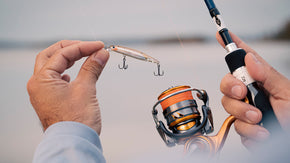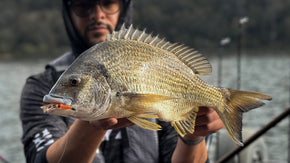Posted 22th October 2025
How to Choose Which Fishing Lure to Use


By Robert Thornton
Fishing is one of those activities where learning is constant, and mistakes are nearly guaranteed. This is even more true when using lures, and anyone new to lure fishing will tell you how daunting it can be making basic decisions. One of the decisions that newcomers often battle with is, ‘what fishing lure should I use?’
While this is a subjective question that requires context and nuance to answer, there are things an angler can do to make this decision easier. A bit of knowledge about different lure types and fish species goes a long way when choosing a lure to tie on. At the same time, knowing the properties of each individual lure will fast-track this process further.
Let’s jump in and see how we can make this decision easier for ourselves!
LURE FISHING: THE BASICS
Lure fishing differs a lot from bait fishing. In bait fishing, the idea is to set baited rigs and wait for the fish to come to you, as opposed to lure fishing, which involves casting and retrieving lures in an effort to find the fish.
Another unique element to lure fishing is the number of presentation options it gives you. In bait fishing you only have one or a couple of different bait options at a time, whereas lures give you the ultimate in flexibility of presentation, with different colours, sizes, depths and swimming actions available, even if you only have a handful of lures with you.
I’m a firm believer that the right lure for the job can be as effective, if not more effective, than any bait in just about any situation. But how do you choose the ‘right lure for the job’?

CHOOSING A LURE
When it comes to choosing a lure, you’ll need to take a variety of factors into account. In this section we’re going to explore some of those factors and how they relate to different lures, and hopefully you’ll be in a better position to choose a lure next time you feel the pangs of indecision on the water! This section will be broken down into five parts: depth, size, colour, feel and action. Let’s go!
Depth
One of, if not the most important things to consider, is the depth a lure runs at. I like to explain the importance of depth in the following way: you can have a lure that mimics the size, colour, feel and swimming action of a prey item, but if it’s swimming at a depth far away from the target species, it’s next to useless.
In a lot of cases, predatory fish are reluctant to suddenly change their position in the water column, and this may be because of barometric pressure, fear of exposure to predators below and above the water, water temperature and so on. Granted, some species will happily move considerable distances up or down for a feed, but for the most part, if you’re not presenting the lures at the depth of the fish you’re targeting, you’re not really in the ballgame. In those instances where fish will change their depth to eat a lure, the distance usually isn’t super far, the light is low (thus limiting the threat of predation) and the air temperature is neither too hot nor too cold.
To put this theory into practise with an example, let’s imagine barra feeding in the back of a bay on an impoundment. Boils from feeding fish indicate that shallow-running or surface presentations are a logical choice, and something that imitates local garfish or frogs are most likely to get eaten. A smart angler would therefore opt for something like a Double Clutch 115 or a Bait Junkie Kikker Curly Big.
To use another example, snapper located on the sounder feeding near the bottom in 15m of water are best targeted with a lure that runs at a deep depth. At this depth, sinking lures are going to be the best option, with something like a Bait Junkie 5” Jerkshad on a 1oz jighead in #5/0 perfect for reaching these fish.

Size
Size is another important aspect of lure choice. In most cases, the size of the lure should roughly approximate the size of the local forage, if the forage is known. If not, the angler may need to take an educated guess at what sort of prey items the fish are eating and how big these items are.
The size of the lure also includes shape. Trout anglers know the importance of shape very well, especially in instances where the trout are fixated on a particular forage. For example, trout feeding on small yabbies about 3-4cm long require a lure of a similar size and shape to the yabbies. A Bait Junkie 2.35” Prawn, while close to the right size (especially if trimmed down), is still far from the profile of a freshwater yabby. A better choice would be a Bait Junkie Risky Critter, and trimming it back to just past the first set of legs will render it a pretty close match.
Colour
Lure colour is one of those things that matters a lot in some situations, and less so in others. Working in a tackle shop, my colleagues and I will often joke that lure colour catches the angler before it catches the fish. In any case, I always try to match my lure colour to whatever prey item the fish are eating.
In situations where the fish are being fussy, such as the trout example above, colour is a factor that the angler can control and harness in order to present the fish with something that looks edible. Given the colour of the average freshwater yabby, darker colours would be a logical choice, with Mud Blood UV, Caramel Candy and Watermelon Red likely to produce a convincing yabby imitation.
Other times, visibility is the aim of the game. To illustrate, whenever I go down to my favourite bass creek and find the water level high and the clarity dirty, I opt for bright, fluoro colours that stand out in the murky sludge. Conversely, when the level is low and the water clear, I like natural or translucent colours to coax a bite out of weary fish, which aren’t as likely to venture out into the open and expose themselves to examine something that doesn’t look real.

Feel
’Feel’ refers to the physical texture of the lure, and once again, there are instances where feel really matters, and other times where it doesn’t as much. Fish are more likely to grab a lure with intention if it looks real, and more likely to hold on if it feels real.
Sometimes the fish are that switched on that it doesn’t matter what the lure feels like; you’re going to hook plenty of fish because they are eating the lure with intention, leading to a high hook-up rate.
Other times, tentative fish will nip at the back of the lure or swipe at it half-heartedly, resulting in a poor hook-up rate. These fish are likely to give up on a lure that doesn’t feel like their natural food source, and more likely to come back for more if it feels like the real deal.
Let’s use another example. Catching bass with surface lures can sometimes depend on the feel of the lure for success, especially when the bass are short-striking. Lures like the Drown Dragonfly are perfect in this scenario, as they have a soft, squishy abdomen made of soft plastic, a hard plastic thorax and head, and thin, bristly wings. If a bass has a go at the Dragonfly and misses the hooks, that fish is more likely to come back for another go because it has a realistic feel. A Slippery Dog 65, while highly effective when bass are switched on and chasing moving prey, is less likely to get a second chance in this scenario, as the whole body is hard and doesn’t accurately mimic the soft prey it’s designed to imitate.
Action
The action of a lure refers to what it does in the water. Most lures will do something when retrieved steadily. It’s worth noting, however, that extra action can be imparted by the angler, with movements in the rod, variation in the retrieve and so on.
Often, I’ll choose a lure based on the diversity of actions I can achieve with just that lure, as this will give me a few presentation options in one. A great example of a lure with multiple actions is the Infeet Sazanami 60SP. A long, slender design, this lure imitates small baitfish and prawns and is popular with anglers chasing bream, bass and trout. When wound steadily, it gives off a gentle shimmy, diving down about 2ft.
A straight wind is one way to work this lure, however, as the SP at the end of its name suggests (suspending), this lure will sit perfectly level when paused. Leveraging this feature, anglers will impart a few sharp twitches to get the lure darting erratically, before pausing the Sazanami and letting it sit there motionless like a disorientated baitfish. Another way to impart action is to burn the lure quickly for a metre or two before stopping abruptly, again allowing the lure to sit there for a few seconds.
A lure like this with multiple actions allows the angler the benefit of trial-and-error, meaning they can employ different actions to see whether the fish are responding to a particular one.
THE ETERNAL DILLEMA
Picking a lure to send out into the yonder can become a nightmare with so many options out there, but hopefully this blog has given you some tools to help make this process easier. Most of the time there isn’t just one lure that will work, but it always helps to try work out which lure in your box is the best fit for the situation you’re faced with by using the criteria outlined above.
So next time you find yourself dithering over which lure to tie on, always remember, depth, size, colour, feel and action!
















